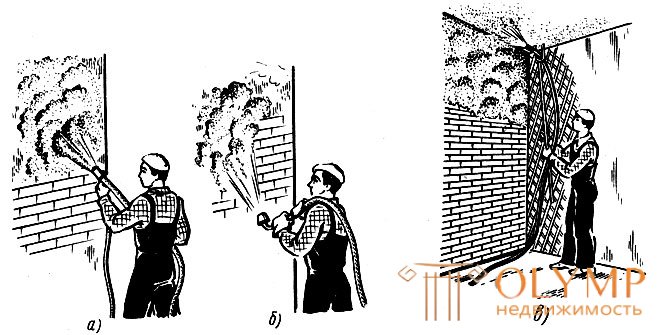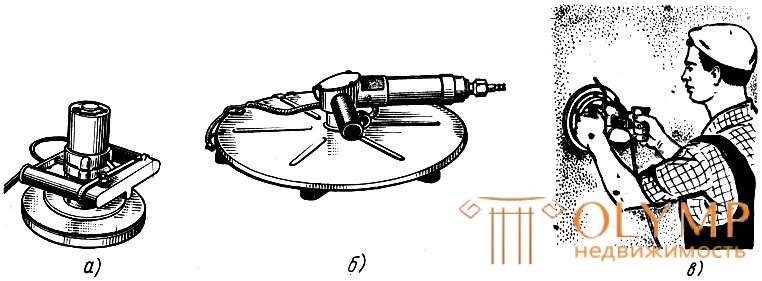
Application of the solution. Mortar pumps pump over lime-sand mixed and cement solutions of composition from 1: 2 to 1: 3 (cement: sand). In the lime-gypsum solutions of the composition from 1: 0.5: 2 to 1: 1: 3 (lime mortar: gypsum: sand) a setting retarder is necessarily introduced. To prepare the solution, first, the gypsum binder is closed on the retarder, then a lime mortar is added to it and everything is mixed in a mortar mixer.
The ease of transfer of the solution through pipelines depends on the fat content of the lime paste, the grade of gypsum, the brand of cement, and especially on the quality of the sand. The sharper the sand with grains no larger than 1.5 mm, the better the solution is pumped. To improve the pumping of solutions, plasticizing agents, such as lime or clay, are added to them. Clay is introduced into the solution in the form of earthen milk of 50% concentration (the depth of immersion of a standard cone is 14 cm). Instead of earthen milk, you can use coarse ground clay powder in an amount up to 8% of the volume of binders.
Before applying the solutions are filtered through sieves. The mobility of the solution for spray and soil without plaster is 6-10 cm, for a covering layer containing a gypsum binder, 9-12 cm, without a binder, 7-8 cm.
Solutions with a draft of a cone 10-12 cm are applied by mechanical nozzles, with a draft of a cone 7-9 cm - pneumatic.
During the application of the spray and primer solution, the nozzles are held to the surface to be plastered at an angle of 60-90 °, while applying the spray on the edge - at an angle of 60 °. The solution is applied by moving from top to bottom and in layers of the following thickness: for splashing on wooden surfaces - no more than 9 mm, on stone, brick, concrete surfaces - not more than 5 mm. The soil layer should not exceed 8 mm with lime-gypsum mortars, 7 mm - with lime and cement-lime mortars, 5 mm - with cement mortars. So that the solution does not crawl when re-applying, the previous layer of the solution must harden.
The nozzle (fig. 97, a - c) is held in by hand or laid on the shoulder during operation. When applying the solution to the ceilings while working from the floor, the nozzle can be fixed on the plug.
Before applying the solution onto the walls along them, they put roofing paper, roofing felt, glassine: it is more convenient to remove the solution that fell during plastering from them than from the floor.
The soil should be well leveled. Patch is applied most often manually: using a spatula with a falcon, a bucket or a shovel. The thickness of the covering after grouting should be no more than 2 mm, but if the ground is not exactly leveled, the thickness of the covering increases. Coat can be applied and the nozzle, but a very thin layer. At the same time, the soil is moistened with water, which makes it possible to level the coating solution with a thin layer.
Prior to the start of the mechanized application of the solution, the front of the work is inspected. If the premises of the base to be plastered are not laid, arrange temporary decks or lay wooden shields. After examining the scope of work, the foreman outlines the place from which to start applying the mortar, and reports on what kind of equipment and accessories are needed to perform this type of work.
The driver periodically checks the mobility of the prepared solution with a standard cone. Applies and smoothes the mortar link, which includes plasterer 4th, 2nd and 3rd category. The number of workers depends on the performance of the mortar pump, the type of plaster applied and the method of work organization.
Before applying the solution, the plasterer selects and adjusts the length of the spray of the solution and the spray of its spray, which depend on the type of mortar pump, the compressor power, the nozzle design, the thickness of the solution. With a long torch, the jet can be directed at an angle close to a straight line, with a short torch — only at a right angle.
Spray jet and spray should be such that solution loss is minimal.
An hour before applying the solution, the surface to be plastered is moistened with water using an airbrush or a brush so that water is better absorbed into the surface. Plastering begins with the application of a layer of spray on the ceilings and walls in one room, then move to another, third, etc. If the mortar sets quickly (depending on the season, temperature, and binder), the primer can be applied after 4-5 hours and after the same time covering.

Fig. 97. Application of the solution injectors: a, b - on the wall, in - on the ceiling
The spray nozzle applies the 4th category plasterer, and the 2nd category plasterer pulls out the hoses, collects the fallen mortar and spreads it on the surface to be plastered, helping the working plasterers.
Leveling mortar . When leveling the solution used mortar, wooden and metal lighthouses. Mortar beacons are most often placed vertically, wooden and metal - vertically and horizontally. All beacons, especially solution ones, after each leveling, are cleaned of adhering solution.
For mortar and metal lighthouses, the solution is leveled with a rule, for wood - most often with small ones. For leveling the mortar on the ceiling, wooden handles are tied to the rules or bevels, for which the ropes are tied, and the ropes are pulled along the beacons by the ropes. This work is done by one or two workers. You can nail two pens and lead pulp or a rule together.
To simultaneously level (stretch) the solution on the ceilings and walls, use two templates - the top and bottom. First, the solution is spread on the upper part of the wall. When leveling, the upper template captures half the height of the wall, they can simultaneously pull out the eaves or fillet and part of the ceiling in the form of an excuse-strip with a width of 90-100 cm. When plastering the remaining part of the ceiling, this solution strip is used as a beacon along which the solution is leveled. If you have to make one additional beacon, it is only in the middle of the ceiling, provided that its width between excuses is more than 4 m.
After finishing the upper part of the room with the lower template they level and draw out the solution on the lower part of the wall. For patterns, rules are hung on the walls and ceiling.
After leveling the solution, correcting all defects on the ground, prepare a covering solution, apply it, level it and smooth it down or rub off.
Grout . Machines for grouting plaster are electric and pneumatic.
Electric trowel machine СО-86А (Fig. 98, a) is designed for grouting various plaster solutions. The electric motor of the machine rotates, in opposite directions, the carrying aluminum discs, to which the grouting discs of polystyrene or particle material are attached. Water is used to wet the leveling surface. Handles are fixed in brackets on the engine shield.

Fig. 98. Trowels (a, b) and surface grouting (c): a - electric, b - pneumatic
Pneumatic troweling machine (Fig. 98, b) is designed for grouting various plaster solutions. The machine consists of a pneumatic engine, gearbox and replaceable working discs. The motor housing serves as the handle of the machine. A replaceable zatirochny disk made of wood plastic or PCB or traverse with blades is mounted on the gearbox shaft. For convenience, the machine is equipped with an additional side grip. A sprayer is provided to supply water to the wiped surface, and a safety disk is installed for safety purposes.
Grinding pneumatic and electric machines are also used for grouting plaster.
The technique of working with all machines is the same. First, the engine is turned on, the machine disks are attached to the surface of the plaster (Fig. 98, c), pressure is applied to the machine with the appropriate force and it is driven along the surface with the required speed. Grouting is stopped when they are convinced that the treated surface meets the requirements for it.
To get a cleaner grout, felt or felt pads are attached to the discs, which are nailed or glued.
If the machines have a device for wetting (spraying) the plastered plaster with water, then one person performs the grouting work, if there is no such device, the two of them usually work: one is wiped by the machine, the second is wetted by plaster surfaces and fixes the defects with a rub , and also overwrites such places that it is impossible to wipe the machine.
When grouting, it is necessary to apply precautionary measures in order to avoid those working by electric current, work in electrical protective gloves or gloves, put a rubber mat under your feet. The rotational speed of the discs should be 220- 280 rpm. At lower speeds it is more convenient to work, the solution almost does not spray. At high speeds the solution is strongly sprayed and often the plaster is wiped to the very foundation. With increased rotation, the disc has to be driven across the surface at an accelerated pace.
Что бы оставить комментарий войдите
Комментарии (0)